Gokmen Oz
CALICO: Conversational Agent Localization via Synthetic Data Generation
Dec 06, 2024Abstract:We present CALICO, a method to fine-tune Large Language Models (LLMs) to localize conversational agent training data from one language to another. For slots (named entities), CALICO supports three operations: verbatim copy, literal translation, and localization, i.e. generating slot values more appropriate in the target language, such as city and airport names located in countries where the language is spoken. Furthermore, we design an iterative filtering mechanism to discard noisy generated samples, which we show boosts the performance of the downstream conversational agent. To prove the effectiveness of CALICO, we build and release a new human-localized (HL) version of the MultiATIS++ travel information test set in 8 languages. Compared to the original human-translated (HT) version of the test set, we show that our new HL version is more challenging. We also show that CALICO out-performs state-of-the-art LINGUIST (which relies on literal slot translation out of context) both on the HT case, where CALICO generates more accurate slot translations, and on the HL case, where CALICO generates localized slots which are closer to the HL test set.
Knowledge Distillation Transfer Sets and their Impact on Downstream NLU Tasks
Oct 11, 2022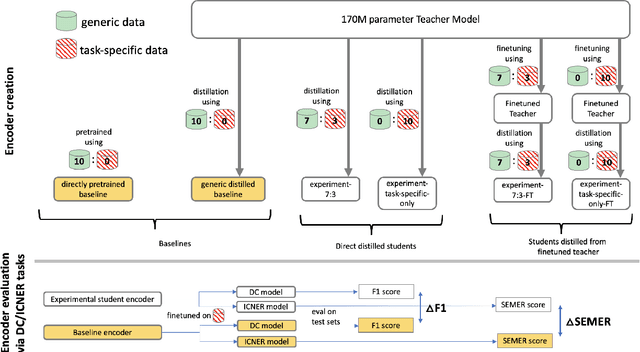


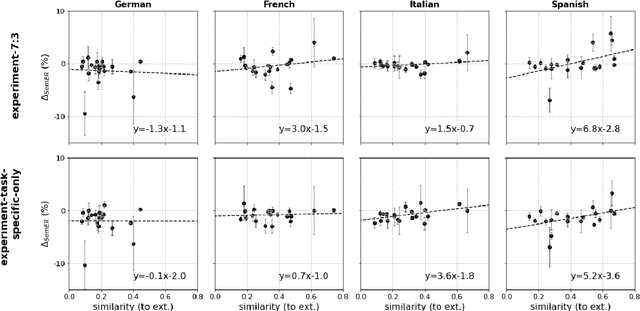
Abstract:Teacher-student knowledge distillation is a popular technique for compressing today's prevailing large language models into manageable sizes that fit low-latency downstream applications. Both the teacher and the choice of transfer set used for distillation are crucial ingredients in creating a high quality student. Yet, the generic corpora used to pretrain the teacher and the corpora associated with the downstream target domain are often significantly different, which raises a natural question: should the student be distilled over the generic corpora, so as to learn from high-quality teacher predictions, or over the downstream task corpora to align with finetuning? Our study investigates this trade-off using Domain Classification (DC) and Intent Classification/Named Entity Recognition (ICNER) as downstream tasks. We distill several multilingual students from a larger multilingual LM with varying proportions of generic and task-specific datasets, and report their performance after finetuning on DC and ICNER. We observe significant improvements across tasks and test sets when only task-specific corpora is used. We also report on how the impact of adding task-specific data to the transfer set correlates with the similarity between generic and task-specific data. Our results clearly indicate that, while distillation from a generic LM benefits downstream tasks, students learn better using target domain data even if it comes at the price of noisier teacher predictions. In other words, target domain data still trumps teacher knowledge.
Alexa Teacher Model: Pretraining and Distilling Multi-Billion-Parameter Encoders for Natural Language Understanding Systems
Jun 15, 2022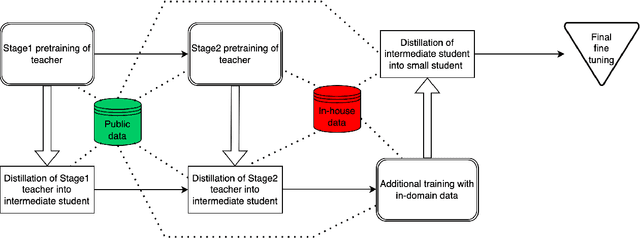
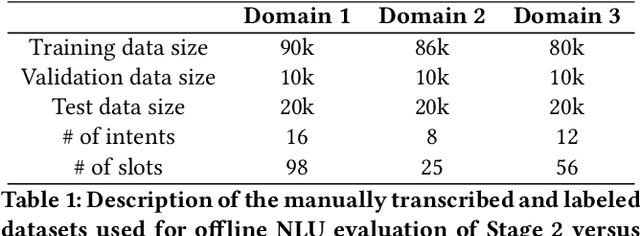
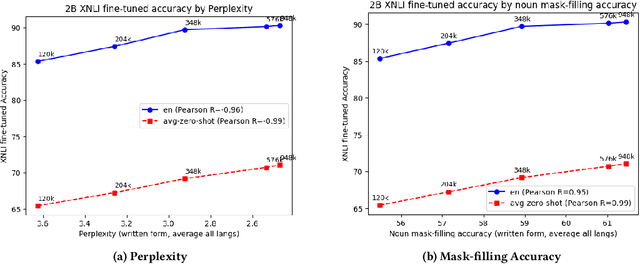
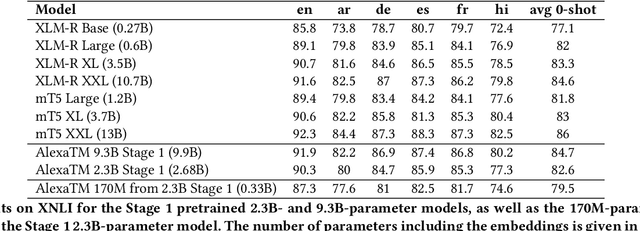
Abstract:We present results from a large-scale experiment on pretraining encoders with non-embedding parameter counts ranging from 700M to 9.3B, their subsequent distillation into smaller models ranging from 17M-170M parameters, and their application to the Natural Language Understanding (NLU) component of a virtual assistant system. Though we train using 70% spoken-form data, our teacher models perform comparably to XLM-R and mT5 when evaluated on the written-form Cross-lingual Natural Language Inference (XNLI) corpus. We perform a second stage of pretraining on our teacher models using in-domain data from our system, improving error rates by 3.86% relative for intent classification and 7.01% relative for slot filling. We find that even a 170M-parameter model distilled from our Stage 2 teacher model has 2.88% better intent classification and 7.69% better slot filling error rates when compared to the 2.3B-parameter teacher trained only on public data (Stage 1), emphasizing the importance of in-domain data for pretraining. When evaluated offline using labeled NLU data, our 17M-parameter Stage 2 distilled model outperforms both XLM-R Base (85M params) and DistillBERT (42M params) by 4.23% to 6.14%, respectively. Finally, we present results from a full virtual assistant experimentation platform, where we find that models trained using our pretraining and distillation pipeline outperform models distilled from 85M-parameter teachers by 3.74%-4.91% on an automatic measurement of full-system user dissatisfaction.
* KDD 2022
Using multiple ASR hypotheses to boost i18n NLU performance
Dec 14, 2020



Abstract:Current voice assistants typically use the best hypothesis yielded by their Automatic Speech Recognition (ASR) module as input to their Natural Language Understanding (NLU) module, thereby losing helpful information that might be stored in lower-ranked ASR hypotheses. We explore the change in performance of NLU associated tasks when utilizing five-best ASR hypotheses when compared to status quo for two language datasets, German and Portuguese. To harvest information from the ASR five-best, we leverage extractive summarization and joint extractive-abstractive summarization models for Domain Classification (DC) experiments while using a sequence-to-sequence model with a pointer generator network for Intent Classification (IC) and Named Entity Recognition (NER) multi-task experiments. For the DC full test set, we observe significant improvements of up to 7.2% and 15.5% in micro-averaged F1 scores, for German and Portuguese, respectively. In cases where the best ASR hypothesis was not an exact match to the transcribed utterance (mismatched test set), we see improvements of up to 6.7% and 8.8% micro-averaged F1 scores, for German and Portuguese, respectively. For IC and NER multi-task experiments, when evaluating on the mismatched test set, we see improvements across all domains in German and in 17 out of 19 domains in Portuguese (improvements based on change in SeMER scores). Our results suggest that the use of multiple ASR hypotheses, as opposed to one, can lead to significant performance improvements in the DC task for these non-English datasets. In addition, it could lead to significant improvement in the performance of IC and NER tasks in cases where the ASR model makes mistakes.
 Add to Chrome
Add to Chrome Add to Firefox
Add to Firefox Add to Edge
Add to Edge